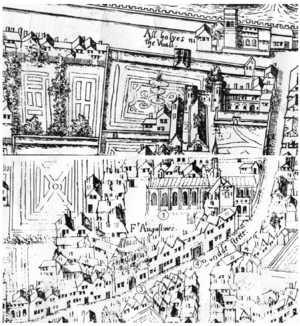James Tyrrell facts for kids
Quick facts for kids
Sir James Tyrrell
|
|
|---|---|
| Born | c. 1445 |
| Died | 6 May 1502 |
| Buried | Austin Friars, London |
| Spouse(s) | Anne Arundel |
| Issue | Sir Thomas Tyrrell James Tyrrell William Tyrrell Anne Tyrrell |
| Father | William Tyrrell |
| Mother | Margaret Darcy |
Sir James Tyrrell (born around 1455, died May 6, 1502) was an English knight. He was a trusted helper of King Richard III of England. Tyrrell is often linked to the mystery of the Princes in the Tower. He reportedly confessed to their deaths under the king's orders. The famous writer William Shakespeare even included Tyrrell in his play Richard III. In the play, Tyrrell is shown arranging the princes' deaths.
Contents
Family Background
James Tyrrell was the oldest son of William Tyrrell. His family lived in a place called Gipping in Suffolk, England. His mother was Margaret Darcy. Her father was Robert Darcy from Maldon. James's grandfather was Sir John Tyrrell.
A Knight's Journey: Sir James Tyrrell's Career
Early Life and Royal Service
James Tyrrell's father was executed in London in 1462. This happened after a supposed plan to harm King Edward IV of England was discovered. We don't know exactly what part Tyrrell's father played. But his family did not lose their lands or titles. James's mother was able to buy back the right to care for her son and his lands.
James Tyrrell fought for the Yorkist side in a big battle called the Battle of Tewkesbury. This battle took place on May 4, 1471. After the battle, King Edward IV made him a knight. A few months later, James started working for Richard III. At that time, Richard was known as the Duke of Gloucester.
Serving King Richard III and Henry VII
When Richard III became king, he gave Tyrrell an important job. In 1484, Tyrrell became the High Sheriff of Cornwall. This meant he was in charge of law and order in that area.
In 1485, Tyrrell was in France. Because of this, he was not part of the Battle of Bosworth Field. This battle was very important. It marked the end of the Yorkist kings and the start of the Tudor dynasty with King Henry VII.
Tyrrell came back to England in 1486. King Henry VII forgave him for his past actions. He was even given his old job back as governor of Guînes. This was a town in Calais, which was an English territory in France.
The Princes in the Tower Mystery
In 1501, Tyrrell supported Edmund de la Pole, 3rd Duke of Suffolk. Suffolk was a Yorkist who wanted to be king. He was living outside England. King Henry VII sent someone to arrest Tyrrell and others.
Years later, a writer named Sir Thomas More wrote about Tyrrell. More said that Tyrrell confessed to the deaths of King Edward V of England and his brother Richard of Shrewsbury, Duke of York. These two young princes are known as the Princes in the Tower. More wrote that Tyrrell said another person helped him. However, Tyrrell could not say where the princes' bodies were. He claimed they had been moved.
It's important to know that the original paper with Tyrrell's confession was never found. Also, other writers from that time, like Polydore Vergil, did not mention this confession. So, historians still debate whether Tyrrell truly confessed or if the story was made up later.
Trial and Execution
Tyrrell was put on trial for treason in London on May 2, 1502. He was found guilty. Four days later, on May 6, he was executed. Another person who helped Suffolk was also executed with him. Sir James Tyrrell was buried at the church of the Austin Friars, London.
Family Life and Descendants
In 1469, James Tyrrell married Anne Arundel. She was the daughter of John Arundel. Together, James and Anne had three sons and one daughter:
- Sir Thomas Tyrrell (died 1551)
- James Tyrrell (died 1539)
- William Tyrrell
- Anne Tyrrell
Their children went on to have their own families. For example, Sir Thomas Tyrrell had a son named Sir John Tyrrell. Anne Tyrrell married Sir Richard Wentworth. They had a son named Thomas Wentworth, 1st Baron Wentworth.
Historical Discussions
Historians continue to study the life of Sir James Tyrrell. In 2015, a historian named David Starkey said he found records. These records suggested that King Henry VII and his wife were present at Tyrrell's trial.
However, other historical documents show something different. These papers suggest that the king and queen were staying at the Tower of London. Tyrrell's trial was held in a different place, not at the Tower itself. This shows how historians use different sources to understand the past.


